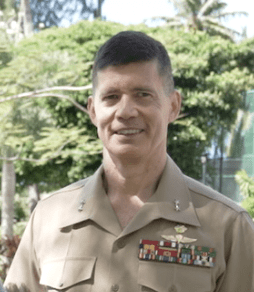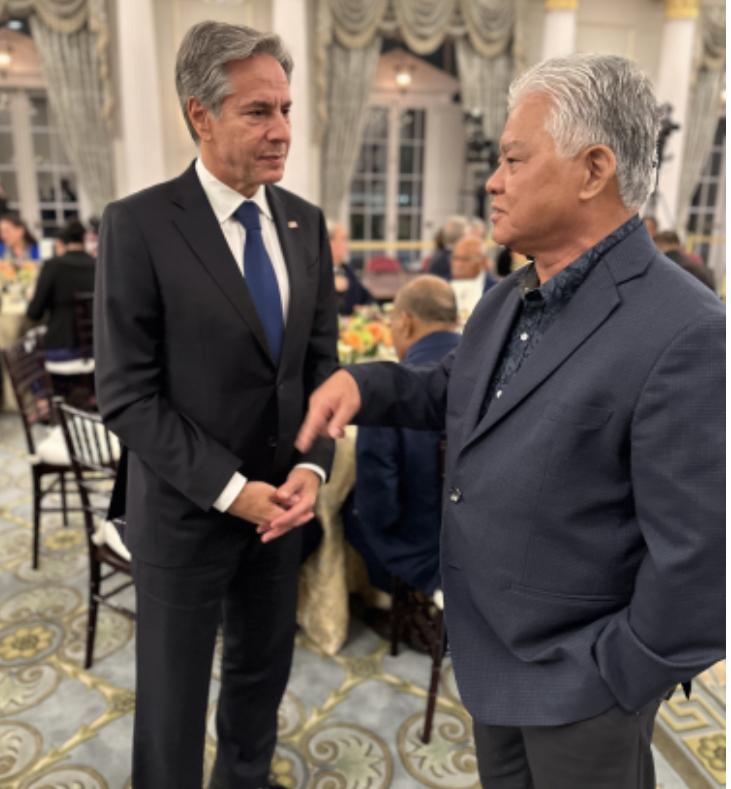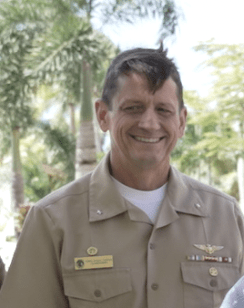The mobilization head of the military command slated to spend $34 billion in this region over the next four years was in Saipan to meet with the CNMI governor about ways the military can be a better partner to the Commonwealth. And the governor – Arnold Palacios – rolled out the welcome mat and an agenda of federal support for more opportunity for his people.
Increasing signals of support from the military and the federal government – an about face by U.S. officials following the radical corruption of the Torres administration – come one year into the new Palacios administration. It has been an administration that continues to be the target of pro-China campaigns by the Commonwealth’s ultra-wealthy, who are holding on for dear life to the de facto oligarchy they built over the decades.
That fidelity to national interests by Arnold Palacios – despite the political capital he has burned – appears to be paying off.

“This is about mutual respect, where we meet as equal partners, making sure that we’re aligned as to the details of all the activities that are coming up, some are short term, some are in the medium term, and some are the long term,” Major General Mark Hashimoto, mobilization assistant to the commander of U.S. IndoPacific Command (INDOPACOM) said in a news briefing following a quarterly military summit in the CNMI. ”The last and most important thing is making sure we continue the momentum for all of these projects.”
Most of the discussion was spent on the concerns of the CNMI, Mr. Hashimoto said. “That led us into our number-one agenda item, and that was on industry day,” Mr. Hashimoto said. “We’re making sure how the people of the CNMI, the businesses here, can find their way into some of the advantages that come with large-scale military projects.”
That has been an objective of the Palacios administration since assuming office in January 2023. The governor has pressed industry and military officials about the use of workers from the CNMI, and the contracting of local companies to ensure military dollars circulate more in the Commonwealth.
“That can be through the federal acquisition process, or it could be jobs that are coming up as a result of our activities,” Mr. Hashimoto said.
“We’re leaning on our Northern Marianas College, our NMTECH, and our labor department, as well as Commerce,” Mr. Palacios said regarding building local capacity to take up military jobs. “We also have to do our part working in tandem with DOD and the contractors … to ensure that we fully participate.”
The face time Mr. Palacios gets with Mr. Hashimoto, and the relationship they have cultivated, may prove meaningful as Congress authorizes funds for the proposed $34 billion Pacific Deterrence Initiative, and the PDI’s yet-to-be-named military buildup projects within INDOPACOM west of the International Date Line. Only two U.S. jurisdictions are within that geopolitical area: the CNMI and Guam.
The entire purpose of the PDI investment is U.S. preparedness because the military has, for years, seen the threat from the People’s Republic of China “as its preeminent pacing challenge,” according to a March 2023 budget submission for its response to this challenge: the PDI.
According to the report, “a great amount of the Department’s investments and efforts are focused on this threat and strengthening Indo-Pacific deterrence.”
“The DoD’ Pacific Deterrence Initiative (PDI) highlights investments specifically for the Indo-Pacific region and criteria defined by the DoD,” according to a statement from the U.S. Indo-Pacific Command spokesperson. “The targeted investments DoD underlined in PDI are U.S. force posture, infrastructure, presence, and readiness in the Indo-Pacific region west of the International Date Line (IDL). Some of the investments are for development and integration of a Joint Missile Defense System for the defense of Guam, infrastructure investments in the Pacific, and regional exercises.”
The first wave of that investment was anticipated to cost $9.1 billion for this fiscal year; an amount budgeted by the President.
“To sustain our military advantage over China, it makes major investments in integrated air and missile defenses and operational energy efficiency, as well as in our air dominance, our maritime dominance, and in munitions, including hypersonics,” U.S. Defense Secretary Lloyd Austin III stated in a March 13, 2023 news release about the budget request. “This budget includes the largest ever request for the Pacific Deterrence Initiative, which we are using to invest in advanced capabilities, new operational concepts, and more resilient force posture in the Indo-Pacific region.”

“Shortly after I was inaugurated as governor earlier this year, I announced the position of my administration that we would pivot away from the commonwealth’s overreliance on Chinese investment, and seek to strengthen our relationships with our federal partners and allies in the region,” Mr. Palacios wrote to Congress early last year. “I worried about the instability of the Chinese markets in light of shifting geopolitical currents. I also worried about the commonwealth’s potential exposure to national security concerns.”
The so-called Palacios Pivot triggered a renewed interest by the federal government to reengage the CNMI government despite the folly of the Torres administration and its close ties with communist China.
In fact, the bureaucratic program offices that coordinate DOD impact spending in the insular areas has reestablished contact with the CNMI government, having taken a hiatus during the Torres regime, and only after witnessing Mr. Palacios’ inaugural address where he signaled support for federal investment.
At the news conference last week, Mr. Palacios said, “We try our best to get everybody in on the discussions,” after emphasizing that he brought to the table all three municipal mayors and several members of the legislature for this second stakeholders meeting with the high-ranking military officials.
He said having a united political voice is important, “so we can maximize – one: benefits the Commonwealth can have – and also maximize the information and awareness that we would have as a community on the activities of the Department of Defense in our communities.”
Before last week’s meeting, Mr. Palacios appeared to be the lone voice in the wilderness struggling to propagate his Palacios Pivot amid calls be influential businesspeople and other politicians bent on reinvesting public resources back to mainland China investment in the Commonwealth.
The push was so pronounced, several members of Congress signed a letter to the Secretary of Homeland Security about the threat communist China poses through the CNMI.
“Also some very important participants in this,” meeting, Mr. Hashimoto noted, “were representatives of the Office of the Secretary of Defense from Washington, D.C. We want to make sure not only is it here what’s going on on the ground, but our partners back in Hawaii and in the continental United States are also a part of this to really show the importance of the CNMI and the contributions that are made to national security.”
In terms of more immediate military investment into the CNMI, the commander of Joint Region Marianas said several opportunities

“I was telling the governor the other day that I was engaging with the commanders of the 7th Fleet to work on encouraging more opportunity to bring ships here to Saipan and throughout the region,” Rear Admiral Gregory Huffman said. “It’s also a benefit to the sailors. Everyone I’ve talked to says they really enjoy having some time off here in Saipan, and I know it’s gonna be a great opportunity for the people here to host ships when they come in to the port. So, we are continuing to work that, and we look forward to an opportunity to bring more ships into the area along with a number of exercises that are gonna go on throughout the region in the next several months.”
Mr. Huffman confirmed the Air Force will be having a large scale exercise next month and that “there will be a substantial number of Air Force airmen and aircraft operating here and throughout the region.”
Also, in June, a larger exercise known as Valiant Shield, “will bring a substantial number of service members and aircraft here to the islands, and just an opportunity for them to enjoy the rich culture and the hospitality here, as well as having a chance to get some really good training.”






3 Comments
Russ Mason
02/05/2024 at 12:22 PM
You left a word out. “The military INTENDS to bring…” all the superlatives mentioned in the article.
Even so, there’s a downside. With a military buildup, the CNMI puts itself in the crosshairs of any real threat, such as Russia or China. As we know, the CNMI was never a strategic target, the way Guam is. (Except perhaps for the nuclear subs parked under an enormous Tinian shelf).
But our local government smells money, lots of it. (This is the equivalent of cutting your finger in front of Dracula). And the Governor and the Legislature are, once again, in full-drool mode.
Yes, perhaps we really need a divert airfield. But let’s stop at that, shall we? If the military want to visit as civilian tourists, no problem. The last thing we need are batallions of uniformed military drawing attention to our lovely, peaceful, islands. That would bring another red circle to enemy maps.
Sadong Tasi Resident
02/06/2024 at 1:00 PM
Your arguments and concerns are well thought out and valid, however when it comes to the Chinese Tourist Market it needs to be understood that that market no longer exists. My wife if a Chinese National and we just got back from China – I don’t think it is realized just how much financial pressure the Chinese middle class are under; the housing market recently imploded with Evergrande, 500 billion lost. A significant percentage of Chinese households just lost their entire life savings as well as having their properties significantly devalued. They are heading towards a long term recession.
As for military threats, Saipan has always been a target for the simple fact it has an airport.
This is the reality: there is 38 billion behind door number one, and a pipe dream behind door number two.
Russ Mason
02/07/2024 at 12:28 PM
Thanks for the kind reply. I also have a Chinese family. When our young man worked at DFS, a Chinese tourist paid $22,000 cash for a real Chanel clutch purse.
Friends of my wife stayed at the Kensington and treated us to the luncheon buffet. Pricey!
My point is there are wealthy Chinese who prefer Saipan to Hainan, and who have lots of money. There are many millionaires in the PRC!
Yes, the average Chinese person is in dire straits, and the government doesn’t care, and never did. I find no fault with your assessment of how terrible things are.
Another severe problem is the extraordinary pollution. When we were in Shenyang, it was so terrible that the sun was a pale disk in the sky. Moreover, the pollution increases almost every day.
We’re fortunate to live here. But I never heard of Sadong Tasi. Sounds like a dish with noodles.
Xie xie!
.